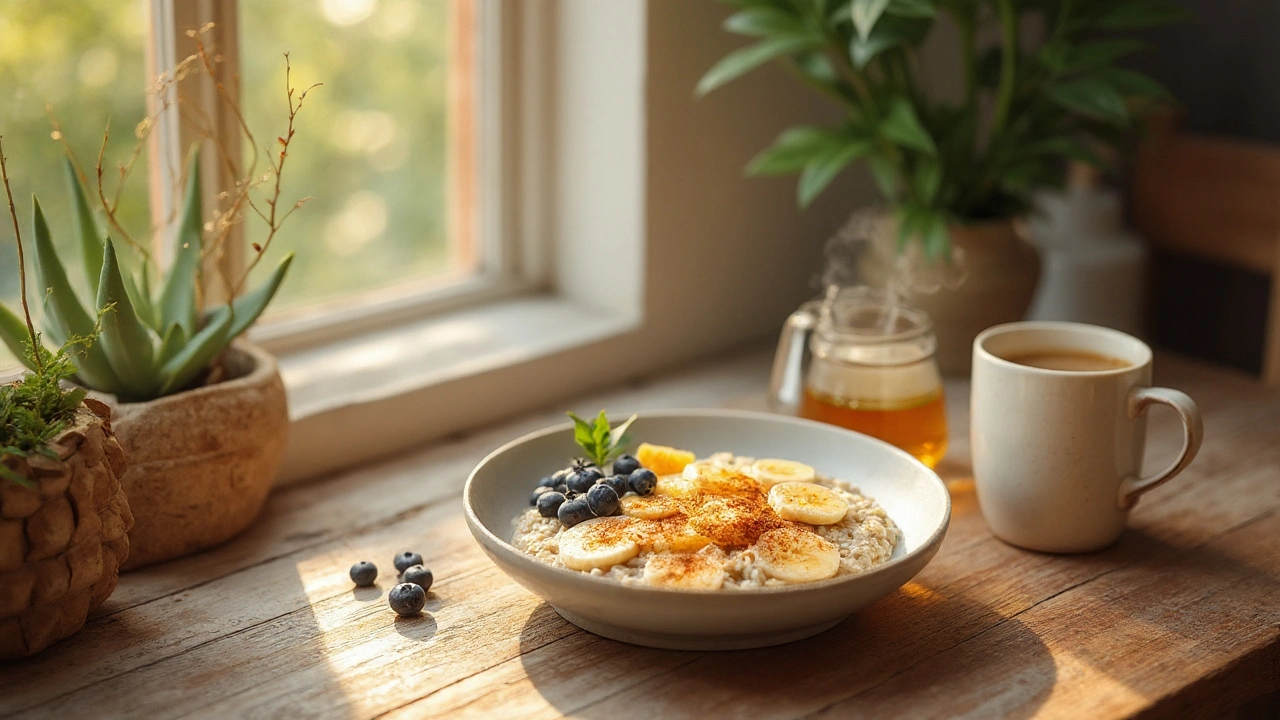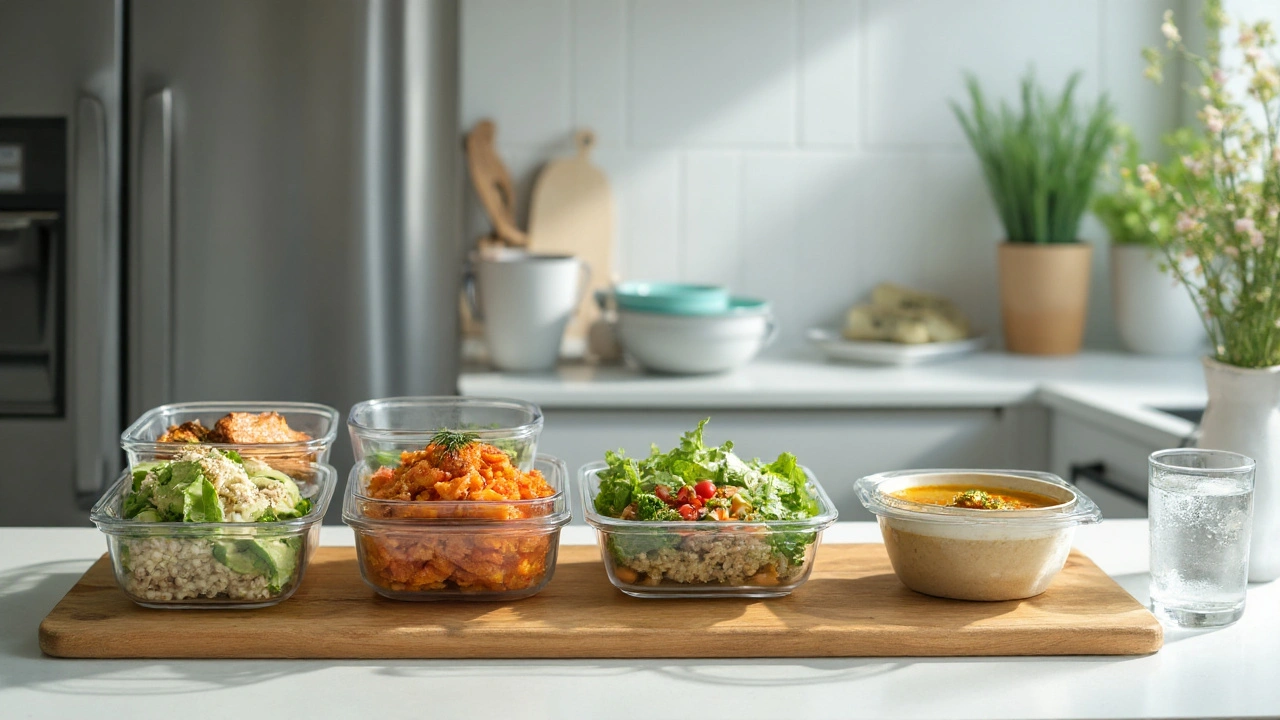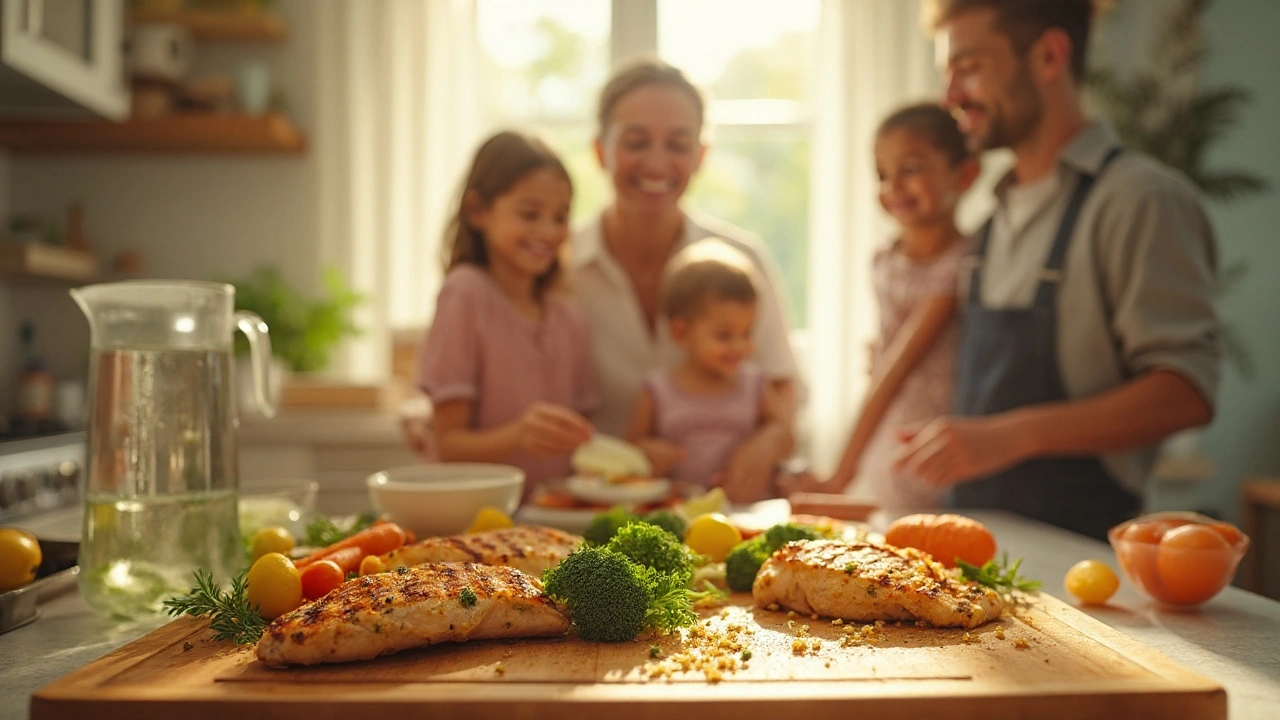Heartburn‑friendly Meal Plan is a dietary framework designed to minimize gastroesophageal reflux triggers while providing balanced nutrition. If you’ve ever dreaded that burning sensation after a tasty meal, you’re not alone. Millions struggle with acid reflux, and the right food choices can turn that nightmare into a manageable routine. This guide shows you exactly how to craft a meal plan that keeps the fire down, packs flavor, and fits into a busy lifestyle.
TL;DR - Quick Wins for a Reflux‑Savvy Kitchen
- Swap high‑fat, fried foods for grilled or steamed lean proteins.
- Choose low‑acid fruits (bananas, melons) over citrus.
- Eat smaller portions and finish meals at least 3hours before bed.
- Load up on fiber‑rich veggies like broccoli, carrots, and leafy greens.
- Stay hydrated, but avoid large drinks during meals.
- Follow the 7‑day sample menu for a ready‑to‑cook plan.
Understanding the Triggers: From GERD to Fatty Foods
To build a plan that works, you need to know what sets off heartburn. The medical term for chronic reflux is Gastroesophageal Reflux Disease (GERD). GERD occurs when the lower esophageal sphincter relaxes inappropriately, allowing stomach acid to splash back into the esophagus. The most common dietary culprits are:
- Acidic foods (tomatoes, citrus, coffee) that lower the pH of stomach contents.
- Fatty foods (fried dishes, full‑fat dairy) that slow gastric emptying.
- Large Portion sizes that increase pressure on the sphincter.
- Late Meal timing that lets acid sit while you lie down.
Conversely, foods rich in Dietary fiber help absorb acid and promote faster gastric emptying. The key is balance, not deprivation.
Core Principles for a Heartburn‑Friendly Meal Plan
- Low‑fat, high‑protein sources: Choose skinless poultry, white fish, tofu, or legumes. Grill, bake, or steam instead of frying.
- Low‑acid produce: Opt for bananas, melons, apples (peeled), cucumbers, and leafy greens. Avoid oranges, grapefruits, and tomatoes.
- Complex carbohydrates: Oatmeal, brown rice, quinoa, and whole‑wheat pasta provide steady energy without triggering reflux.
- Fiber boost: Add carrots, broccoli, sweet potatoes, and chia seeds. Aim for at least 25g fiber daily.
- Controlled portions: Keep meals to 400‑600kcal, roughly the size of a clenched fist.
- Timing strategy: Finish dinner at least 3hours before sleep; snack only if needed, choosing a low‑fat, low‑acid option.
- Gentle seasonings: Use ginger, turmeric, cumin, and fresh herbs. Skip hot sauces, pepper, and mint, which can relax the sphincter.
Acidic vs Low‑Acid Foods: Quick Comparison
| Attribute | Acidic Foods | Low‑Acid Foods |
|---|---|---|
| Typical pH | 2.5‑4.0 | 5.5‑7.0 |
| Common Examples | Tomatoes, citrus, coffee, wine | Bananas, melons, oats, leafy greens |
| Reflux Trigger Rating | High | Low |
| Preparation Tips | Use sparingly, pair with neutral foods | Can be consumed freely, ideal base ingredients |

7‑Day Sample Menu (Heartburn‑Friendly)
Below is a ready‑to‑cook week of meals. Each recipe follows the core principles above, and calories stay in the 1,200‑1,500kcal range for an average adult.
Day 1
- Breakfast: Cream of wheat topped with sliced banana and a drizzle of honey.
- Lunch: Grilled chicken salad with mixed greens, cucumber, shredded carrots, and a light olive‑oil‑lemon vinaigrette (use only a splash of lemon).
- Dinner: Baked cod with rosemary, quinoa, and steamed broccoli.
Day 2
- Breakfast: Oatmeal cooked in almond milk, stirred with grated apple and cinnamon.
- Lunch: Turkey wrap in a whole‑wheat tortilla, lettuce, avocado slices (½avocado), and a smear of low‑fat Greek yogurt.
- Dinner: Stir‑fried tofu with ginger, snap peas, and brown rice.
Day 3
- Breakfast: Smoothie with spinach, pineapple (small amount), banana, and oat milk.
- Lunch: Lentil soup (low‑sodium) with a side of whole‑grain toast.
- Dinner: Grilled salmon, mashed sweet potatoes, and sautéed green beans.
Day 4
- Breakfast: Scrambled egg whites with diced bell pepper and a slice of whole‑grain toast.
- Lunch: Quinoa bowl with chickpeas, roasted zucchini, and a dash of tahini.
- Dinner: Turkey meatballs in a mild herb broth, served over barley.
Day 5
- Breakfast: Greek yogurt (low‑fat) topped with sliced peaches and a sprinkle of flaxseed.
- Lunch: Baked sweet potato stuffed with black beans, corn, and a spoonful of salsa (mild).
- Dinner: Pan‑seared tilapia, couscous, and roasted carrots.
Day 6
- Breakfast: Overnight oats with chia seeds, almond milk, and diced mango (small).
- Lunch: Chicken and vegetable stir‑fry using olive oil, ginger, and low‑sodium soy sauce.
- Dinner: Baked eggplant, brown rice, and a side salad with olive‑oil dressing.
Day 7
- Breakfast: Whole‑grain pancakes topped with a thin layer of pure maple syrup and fresh blueberries.
- Lunch: Tuna salad with leafy greens, cucumber, and a drizzle of lemon‑yogurt dressing.
- Dinner: Spaghetti squash with a tomato‑free basil pesto and grilled shrimp.
Feel free to swap proteins or veggies based on personal preference, but keep the acid‑ and fat‑level guidelines in mind.
Shopping & Prep Tips for Busy Lifestyles
- Batch cook grains: Cook a big pot of quinoa, brown rice, or barley on Sunday; store in airtight containers.
- Pre‑portion proteins: Grill several chicken breasts, fish fillets, or tofu blocks and freeze in single‑serve bags.
- Veggie prep: Wash, slice, and store low‑acid veggies in zip‑top bags for quick salad assembly.
- Smart seasoning kit: Keep ginger, turmeric, garlic powder, and fresh herbs on hand; they add flavor without reflux risk.
- Hydration strategy: Sip water throughout the day, but limit intake during meals to 4‑6oz.
Monitoring Your Progress & Tweaking the Plan
Track symptoms for two weeks using a simple log: note time of meals, portion size, and any heartburn episodes. If you notice recurring discomfort after a particular food, replace it with a lower‑risk alternative. Over time you’ll develop a personalized version of the plan that fits your taste buds and schedule.
Related Concepts: Lifestyle Factors That Complement Your Meal Plan
While food is a major player, other habits amplify success:
- Weight management: Even a 5‑% reduction in body weight can lower abdominal pressure on the sphincter.
- Smoking cessation: Nicotine relaxes the lower esophageal sphincter, worsening reflux.
- Alcohol moderation: Limit to one standard drink per day; avoid binge drinking.
- Post‑meal walking: A gentle 10‑minute stroll aids digestion and reduces reflux.
Integrating these lifestyle tweaks with the heartburn‑friendly meal plan creates a comprehensive reflux‑management strategy.

Frequently Asked Questions
Can I still enjoy coffee on a heartburn‑friendly diet?
Coffee is acidic and can relax the esophageal sphincter, so it often triggers reflux. If you can’t quit, try low‑acid cold brew, limit to one cup, and avoid adding high‑fat milk or sugar.
Are fruit juices banned completely?
Most fruit juices, especially orange or grapefruit, are high in acid and can provoke heartburn. Opt for diluted carrot or cucumber juice, or stick with whole low‑acid fruits.
How much fiber should I aim for each day?
Aim for 25‑30grams of dietary fiber daily. This helps absorb excess stomach acid and promotes smoother digestion. Include oats, beans, vegetables, and whole grains in every meal.
Is it okay to eat spicy foods if I have GERD?
Spices like chili powder or hot sauce can relax the lower esophageal sphincter, increasing reflux risk. However, milder spices such as ginger, turmeric, and cumin are generally safe and can even aid digestion.
What’s the best time to eat my last meal?
Finish dinner at least three hours before you lie down. This gives your stomach time to empty and reduces the chance of acid spilling into the esophagus while you sleep.
Can I still enjoy desserts?
Yes, choose low‑fat, low‑acid options like rice pudding, baked apples, or a small scoop of vanilla ice cream (limit portion). Avoid chocolate, citrus‑based cakes, and heavy custards.

Murhari Patil
September 22, 2025 AT 16:53The kitchen conspiracies are real, they hide the fire.
kevin joyce
September 23, 2025 AT 15:07From a gastroenterological systems theory perspective, the integration of low‑acid macronutrients facilitates sphincteric compliance while mitigating acidic load. This synergistic approach resonates with biophysiological homeostasis paradigms. Moreover, the fiber augmentation aligns with luminal buffering mechanisms. In essence, the diet operationalizes a multi‑factorial mitigation strategy that transcends mere caloric restriction.
michael henrique
September 24, 2025 AT 13:20Anyone who doubts the superiority of home‑grown, American‑sourced lean proteins clearly lacks patriotism and proper nutrition sense.
Jamie Balish
September 25, 2025 AT 11:33I love how this plan respects both flavor and health, which is a rare combo.
First, the emphasis on lean proteins means you won’t feel weighed down after meals.
Second, swapping out acidic fruits for bananas and melons is a smart move for reflux sufferers.
Third, the portion control advice aligns perfectly with sustainable eating habits.
Fourth, the timing tip of finishing dinner three hours before sleep tackles the root cause of nighttime heartburn.
Fifth, the inclusion of fiber‑rich veggies like broccoli and carrots helps absorb excess acid.
Sixth, the sample menu gives concrete examples so you don’t have to reinvent the wheel.
Seventh, batch cooking grains on Sundays saves time during busy weekdays.
Eighth, pre‑portioning proteins keeps the fridge organized and reduces decision fatigue.
Ninth, the gentle seasonings list shows you can still enjoy taste without triggering reflux.
Tenth, the hydration strategy reminds you that even water can be a culprit if over‑consumed during meals.
Eleventh, the lifestyle tips like post‑meal walks integrate movement for better digestion.
Twelfth, the advice to track symptoms creates a feedback loop for personalizing the plan.
Thirteenth, the recommended weight management reminder highlights the mechanical pressure factor.
Finally, the overall tone of the guide is encouraging rather than restrictive, which keeps motivation high.
Jeff Bellingham
September 26, 2025 AT 09:47The guide is adequately comprehensive, yet it borders on verbosity in certain sections. While the scientific underpinning is sound, some readers may prefer a more succinct presentation. Overall, it fulfills its educational purpose without unnecessary flamboyance.
Matthew Balbuena
September 27, 2025 AT 08:00Yo, this plan is lit! I love the vibe of batch cooking – saves mad time.
Just a heads up, you can swap the quinoa for millet if you want a twist.
Don’t forget to add a pinch of cinnamon to your oatmeal, it’s yum and easy on the gut.
Keep it colorful and keep it real.
michael abrefa busia
September 28, 2025 AT 06:13Great job on the layout! 👍👍 It’s super helpful to have a clear day‑by‑day menu.
If anyone’s looking for extra motivation, remember to celebrate each small victory – even a reflux‑free lunch counts! 🌟 Keep the positivity flowing! 🎉
Bansari Patel
September 29, 2025 AT 04:27The philosophical underpinning of this diet mirrors the balance between fire and water within our bodies. By respecting the limits of the esophageal sphincter, we honor the body’s own governance. Yet, we must remain vigilant; any slip can reignite the inferno.
Rebecca Fuentes
September 30, 2025 AT 02:40Thank you for presenting this information with such cultural sensitivity and academic rigor. The inclusion of diverse dietary traditions enhances the guide’s applicability across populations. I anticipate its adoption in both clinical and community settings.
Jacqueline D Greenberg
October 1, 2025 AT 00:53Hey, this is super useful! I’m gonna try the overnight oats tomorrow – hope it keeps the burn away. Also, love the tip about finishing dinner early, totally gonna give it a go.
Jim MacMillan
October 1, 2025 AT 23:07While the recommendations are adequate, one must consider the nuanced biochemical pathways that underlie gastric acidity. A simplistic approach may overlook the complex interplay of gastrin, histamine, and proton pumps. Nonetheless, the menu provides a decent foundation for the layperson. 😏📚
Dorothy Anne
October 2, 2025 AT 21:20You’ve got this! Start with the breakfast ideas and watch your evenings get calmer. Remember, consistency beats perfection every time. Keep pushing forward, and those flare‑ups will become a thing of the past.
Sharon Bruce
October 3, 2025 AT 19:33Fine, I’ll admit the plan works, but I still think the portion sizes are a bit restrictive. 😑
True Bryant
October 4, 2025 AT 17:47Let’s be clear: this guide is the epitome of evidence‑based dietary engineering, not a vague wellness buzz‑feed. It synthesizes pathophysiological insights with pragmatic culinary tactics, thereby delivering a clinically robust framework. Anyone dismissing it as “just another diet” is neglecting the substantial peer‑reviewed literature that underpins each recommendation. In short, adhere to the protocol, or continue wrestling with uncontrolled reflux. Choose wisely.